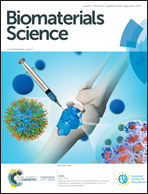A pH and reduction dual-sensitive polymeric nanomicelle for tumor microenvironment triggered cellular uptake and controlled intracellular drug release†
Abstract
Minimal drug leakage during blood circulation and intracellular drug delivery in tumor sites are of great significance in chemotherapeutics. Herein we propose an interlayer crosslinked polymeric micelle with tumor acidity and reduction dual sensitivity for highly efficient drug delivery to cancer cells. A novel copolymer mPEG-C![[double bond, length as m-dash]](https://www.rsc.org/images/entities/char_e001.gif) N-PAsp(MEA)–CA was synthesized and self-assembled into a dual-sensitive interlayer-crosslinked micelle (ICM). The micelle was composed of a tumor acidity sheddable PEG outer layer, a reduction-sensitive disulfide-crosslinked interlayer (PAsp(MEA)) and a hydrophobic core of cholic acid (CA) for doxorubicin (DOX) delivery. The nano-sized ICM was stable and showed little drug leakage in a neutral physiological environment. In tumor microenvironments (TMEs) with mild acidity, the PEG outer layer was readily detached due to the hydrolysis of the Schiff base linker, and the surface of the ICM was switched to positively charged to enhance the cellular uptake. Furthermore, inside tumor cells DOX was rapidly released due to the reduction of disulfide bonds by glutathione (GSH). The DOX-loaded ICM exhibited an effective anticancer effect against C6 glioma and reduced side effects both in vitro and in vivo. The study reveals that this pH and reduction dual-sensitive micelle may have great potential to mediate effective anticancer therapy.
N-PAsp(MEA)–CA was synthesized and self-assembled into a dual-sensitive interlayer-crosslinked micelle (ICM). The micelle was composed of a tumor acidity sheddable PEG outer layer, a reduction-sensitive disulfide-crosslinked interlayer (PAsp(MEA)) and a hydrophobic core of cholic acid (CA) for doxorubicin (DOX) delivery. The nano-sized ICM was stable and showed little drug leakage in a neutral physiological environment. In tumor microenvironments (TMEs) with mild acidity, the PEG outer layer was readily detached due to the hydrolysis of the Schiff base linker, and the surface of the ICM was switched to positively charged to enhance the cellular uptake. Furthermore, inside tumor cells DOX was rapidly released due to the reduction of disulfide bonds by glutathione (GSH). The DOX-loaded ICM exhibited an effective anticancer effect against C6 glioma and reduced side effects both in vitro and in vivo. The study reveals that this pH and reduction dual-sensitive micelle may have great potential to mediate effective anticancer therapy.



 Please wait while we load your content...
Please wait while we load your content...